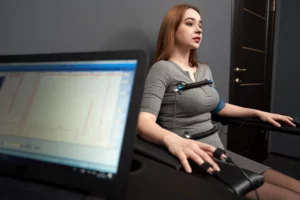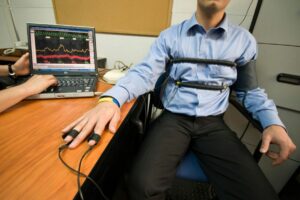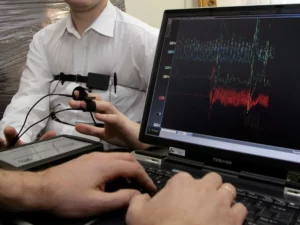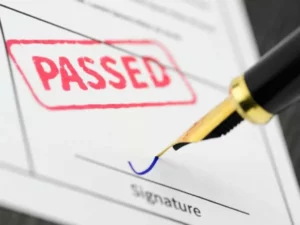The polygraph machine, also known as a lie detector, is commonly used in a variety of contexts, such as law enforcement, national security, and employment screening. It is often relied upon as a tool for interrogation as well as a screening method for sensitive positions held by law enforcement officers, intelligence personnel, and government officials.

The device measures physiological responses that include changes in blood pressure, heart rate, breathing rate, and skin conductivity, among other things. As lying frequently results in an increase in these, they are regarded as indicators of deceit.
In this article, we will provide more insight into how the polygraph actually works, the science behind it, and how it is used in a number of settings.
The importance of understanding how a polygraph works
Whether you are taking one or simply curious about how it works, having a clear understanding of the rationale behind it can help you make accurate choices that can have significant consequences. False positives, which occur when a truthful person is identified as lying, can result in lost job opportunities, damaged reputations, or even criminal charges. Conversely, false negatives, which occur when a liar is identified as truthful, can allow a guilty individual to avoid consequences and perpetuate harmful behavior.
Furthermore, understanding the limitations of polygraphs can help you and organizations make more educated choices about when to use them. For example, while they can be useful for certain objectives, such as identifying specific spots where further investigation is needed, they are not always reliable indicators of truthfulness. By recognizing these, you can avoid placing undue reliance on the results.
The theory behind it

The polygraph is based on the assumption that when people lie, they experience a heightened state of stress or anxiety that can be measured and recorded. They reflect shifts in the autonomic nervous system, which controls primitive bodily functions (heart rate, blood pressure, and breathing).
You are typically asked a series of questions, some of which are designed to trigger those responses when lying. The examiner then looks for patterns in the data to finally determine whether you are telling the truth or not.
It is based on the idea that the body’s responses are largely involuntary and cannot be easily controlled, even by someone who is attempting to deceive.
What happens during the test? step-by-step
- During a typical polygraph exam, you will first be asked to complete a pre-test interview. This helps the examiner establish a baseline for your behaviour and get a better understanding of your emotional state. He will also explain the test and the procedure to you, as well as answer any questions you might have.
- He will then attach sensors to your body, which include a blood pressure cuff, two pneumographs (to measure breathing), and electrodes on your fingers to measure your skin’s electrical conductance.
- Next, he will conduct a “stimulation test” to establish your baseline. This involves asking you a series of neutral questions, such as your name and address. and then intersperse relevant and control questions.
- Once the test is complete, the examiner and the computer’s algorithm will analyse the findings and determine whether you showed signs of deception. The results are typically presented in a written report but can also be provided verbally.
The test relation to the examiner

The tester plays an important part in the accuracy of the results. He is responsible for conducting the test, interpreting the results, and reporting the findings.
In order to be a qualified examiner, they must go through advanced training. Many have backgrounds in law enforcement or psychology, and they must stick to strict principles when administering and interpreting results.
One important aspect of their function is to establish rapport with the examinee. This involves creating a relaxed, non-threatening atmosphere so that you feel comfortable.
They are trained to recognize specific signs of stress and responsible for asking necessary questions while monitoring the graph for reactions.
Their duty is not to determine guilt or innocence but rather to provide an objective assessment of your responses.
The different measurements that are taken

During a typical exam, several physiological metrics are taken:
- A pneumograph, or two air-filled tubes strapped across your chest, to measure respiratory rate.
- Two electrodes will be connected to your fingers to measure the level of sweat secretions and skin conductivity.
- A blood pressure cuff will be placed on your arm to measure heart activity and blood pressure levels.
- A plethysmograph may also be attached to a finger to measure its blood volume.
- Electronic sensors will be placed on your chest to monitor your respiratory levels and rate (not often).
- Motion sensors may also be applied to pick up leg, arm, or anal sphincter movements that may interfere with the test’s data.
- In some modern environments, a microphone will be placed to measure voice stress or a microcamera to measure eye movements.
A few checks will be made to ensure that the sensors are correctly connected and the chart recording system is running. Once everything has been set up properly, the examination will begin.
As mentioned, your physiological reactions stem from three major systems in the body, all of which are controlled by the autonomic nervous system.
These are:
- Cardiovascular System: heart rate, relative blood pressure, and blood volume
- Respiratory System: breathing rate or shallow breathing
- Electrodermal System: sweat gland activity
Blood pressure and heart rate data
This is collected by the arm-encircling cuff, or heart monitor, placed on the upper arm. It is connected to the polygraph and filled with air through tubes.
Changes in the blood pressure modulate the air circulation in the cuff and are registered.
Respiratory system data
The breathing pattern is measured by two devices that record thoracic movements, or volume, that change during respiration.
One of the tubes is wrapped around your chest, while the other is wrapped around your abdomen. The pressure inside these will fluctuate as you breathe in and out, and the device will log this.
Electrodermal or perspiratory data
This will measure the sweat or galvanic skin response using a two-piece galvanometer attached to two of your fingertips.
It works by sending a small electric current into the skin of one finger and recording how much current passes through the other finger.
If you are sweating, the water and salt will encourage the current more than someone whose skin is dry. The amount of electric flow is recorded and reflects the amount of sweat produced at the fingertips.
Question types
Based on your pre-test responses, a predetermined set of questions will be built. They will be given a minimum of three times, and data is continuously collected as you respond. All questions should be discussed and reviewed with you; this gives you an opportunity to make adjustments.
There can be four types, presented in different combinations: relevant, irrelevant, control, and concealed (or guilty) knowledge.
- Relevant Questions: These are directly pertinent to the subject of the interview. It will be your physical responses to these that will be of most interest to your examiner. For example, if you are under investigation for theft, a relevant question would be asked by directly asking if you stole the item in question. However, if your exam is part of a pre-employment check, a relevant question may relate to your entire job history and your stated qualifications.
- Control Questions: The purpose of these is to elicit the same emotional state that you will potentially be in when lying, and therefore they are supposed to be difficult to answer truthfully. For example, when asked, “Have you ever stolen anything?” most people won’t admit this in the environment of a polygraph, but the chances are that they have stolen even the smallest thing during their lifetime. These will be used to provide a base for comparison when analyzing your reactions to relevant questions and are usually unrelated to the subject of the interview.
- Irrelevant questions: Irrelevant questions will be completely unrelated to the subject in question. They can be as simple as “what is the day today?” or “what country are we in?” These are meant to cause you as little stress as possible and provide a foundation from which to judge other questions. Irrelevant questions are interspersed with relevant or control questions.
- Concealed Information Questions: These are only inserted when trying to gather information about a crime of which you are suspected. For example, if the offense in question is theft, questions may be asked about the possible locations of the theft’s occurrence. Examiners will be looking for certain reactions when different locations are suggested, along with a strong physiological reaction expected to indicate that that particular suggested location may be the correct one.
How long does the test take?
Length of the polygraph can vary depending on the complexity of the issue and the number of questions. Typically, it can last anywhere from 1 to 3 hours.
Each question set may last only a few minutes, but you may find that you answer these several times, and you’ll be provided with short breaks, which will add to the overall time.
Collecting data from the equipment typically involves periods of 10–15 minutes at a time.
Reviewing the data and analyzing the results can take anywhere from a few minutes to several hours, depending on the topic and the amount of information collected.
There is always the chance of an examination being cut short due to confession or extended due to inconsistencies in the machine readings.
Further explanation of factors that can influence length

There are a variety of components that can come into play.
- Complexity of the questions being asked. If you’re being asked about a simple matter, such as whether or not you stole a piece of candy from a store, the exam might only take 30 minutes or so. However, if the questions are more complex and require a more in-depth examination, it could take several hours.
- Your own physical condition. If you’re feeling highly anxious or stressed, it may take longer to get accurate readings. Additionally, if you have certain medical conditions, such as heart problems, it may take more time.
- The experience and skill of the examiner. A more experienced examiner may be able to get accurate readings more quickly, resulting in a shorter exam. On the other hand, a less experienced examiner may need to spend more time to ensure they are getting them.
- Finally, the number of questions can also affect the length. The more questions there are, the longer the exam will take. It can vary widely depending on the purpose of the exam and the examiner’s approach.
How the results are interpreted
One common method used to interpret results is called the comparison question technique (CQT). Using this technique, the examiner will compare the responses from control questions (CQ) to relevant questions (RQ).
If the physiological responses to relevant questions are greater than those to control questions, the examiner may determine that you are deceptive.
Another technique is the peak of tension technique (POT). This is based on the idea that when you lie, there will be a momentary spike of anxiety that will be reflected. The examiner will analyse the data for any unusual peaks that occur.
This may seem straightforward and easy, but the examiners analyzing the spikes and dips have had substantial training to look for abnormalities. They search for unusually increased physical reactions, reduced reactions, and those that are uncorrelated in a reasonable timeframe with the questions asked.
The interpretation of the chart will be guided by a computer algorithm and a protocol. The protocol is based on three universal principles:
- Reliability
- Accuracy
- Validity
Reliability is generally used to indicate how many times this procedure has been repeated across different times, places, and subjects. Test-retest reliability measures standard procedure against specific situations.
Accuracy and validity go together. This refers to how well the exam indicated deception and non-deception.
The interpretation of results is not a simple “lie or truth” determination. Instead, the examiner will provide an opinion as to the likelihood that the person was being deceptive or not. He will take into consideration the physiological indicators, the type of questions asked, and several other connected factors.
It is also important to note that the interpretation could be subjective and vary among examiners.
Types of conclusions that can be drawn

There are four possible outcomes:
- Successful: “Deception Not Indicated” (DNI) means that the examiner determined that you were not being deceptive in your responses to any of the questions asked. This can be based on a lack of significant physiological reactions or consistent reactions to both relevant and control questions.
- Failed: A result of “deception indicated” (DI) means that the tester found that you were being deceptive in your responses to one or more of the questions asked. This could be based on a number of factors, such as increased physiological responses when answering specific questions or inconsistent responses between relevant and control questions.
- Inconclusive: An inconclusive result means that he was not able to definitively determine whether you were being deceptive or truthful. This can be due to a number of factors, such as inconsistent physiological responses or an inability to establish a baseline for your responses.
- Purposely Non-Cooperative (PNC): You were caught trying to use countermeasures or did not comply with the given instructions.
Test results are usually provided verbally or via USPS Priority Mail. The average response time is between 2 and 3 days following the exam, but this could take longer depending on the amount of review time. In certain industries, you will receive the results right after the test is completed.
According to various state licensing laws and the American Polygraph Association’s Standards and Principles of Practice, the results can only be released to authorized personnel.
Those who can receive them are you and anyone else who is specifically designated in writing by you, a firm, corporation, or government agency that requested the exam, along with some others who might be required by law.
Is the examiner’s decision final?
Simply put, the examiner’s decision is not final. The results are not deemed definitive until there has been a quality control review. All examiners are held to strict requirements to provide each applicant with fair and accurate protocol.
Quality control consists of senior-level federal examiners. Under the federal procedure, the results are submitted to the management team for final review and determination of the end exam result.
Test errors
The polygraph is not foolproof, and errors do occur, as with any test.
One type is a false positive. This is when the examiner indicates that you are lying when you are, in fact, telling the truth. They can occur when he misinterprets indicators or when a person experiences severe anxiety or nervousness for reasons unrelated to deception, such as being falsely accused.
Conversely, a false negative occurs when the examiner indicates that you are telling the truth when you are, in fact, lying. False negatives can also occur due to a misreading of your physiological data. It is also possible for him to do everything correctly and still have the test result in an error.
If you think there were mistakes in the results, you might be able to appeal them.
Good luck!

